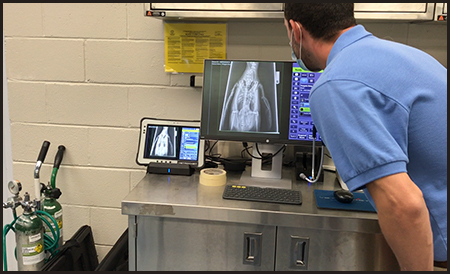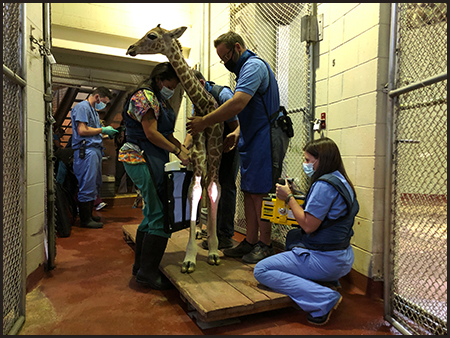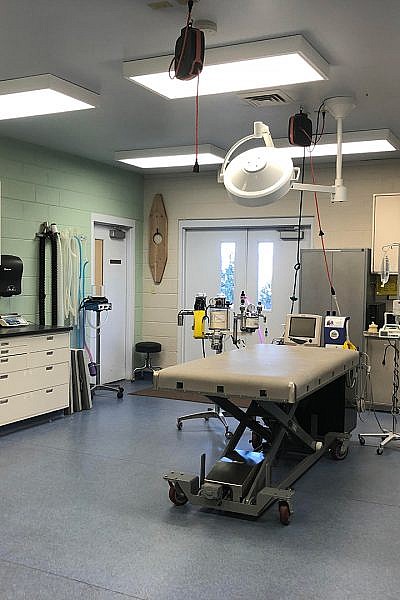One the of many benefits of living at the Zoo is our animals’ access to round-the-clock expert veterinary care. Combined, Cheyenne Mountain Zoo’s veterinary team has more than 100 years of experience in the veterinary field. The team of six brings an extensive background in animal medicine, conservation, research, education, animal husbandry training and clinical practice to the hundreds of animals that live at the Zoo. From elephants to axolotls, their passion for animals of all shapes and sizes is a driving force at CMZoo.

Just like humans, animals get varying levels of medical care. Depending on what a person needs, they might go to their primary care team, or an urgent care or emergency care center. Our partner, Children’s Hospital Colorado has human tips on how to choose the best level of care based on what’s going on.
At CMZoo, the veterinary team works closely with keepers and animal care managers to provide varying levels of care, too.
“Our goal is to provide the best medical care available for our animals, and to care for them in a way that helps them feel in control and confident,” said Dr. Jon Romano, CMZoo head veterinarian. “Unlike human doctors, we can’t explain to our patients what kind of care they need. Animal care teams work with animals to participate in voluntary husbandry training, which means the animals get positive reinforcement – like treats – for doing a behavior we ask of them, and that allows us to care for them with their participation.”
Through husbandry training, animals can receive routine care, like blood draws, vaccinations or x-rays, in their homes. With mobile veterinary equipment and special exhibit ports that allow our vet team to safely access animals, the scene is set for successful, low-stress diagnostics.
“When we’re working with an animal that could potentially be dangerous, we always put our staff safety first,” said Dr. Romano. “Our maintenance team has built ports into many of the animal exhibits, which allow us to draw blood from a grizzly bear’s paw or from an African lion’s tail, for example. Those voluntary blood draws help us track an animal’s health routinely, or address any concerns their care team might have.”
Abuto, CMZoo’s 10-year-old African lion patriarch, deals with ongoing kidney issues. Because of his trusting relationship with keepers and his voluntary trained behaviors, Abuto’s team can give him subcutaneous fluids if he’s not feeling well, right there in his home. They can also track his kidney levels through routine voluntary blood draws. Giraffe, elephants and many more animals at the Zoo participate in voluntary blood draws. With testing equipment at the CMZoo clinic, the veterinary team can get fast results from those blood tests and start treating an animal quickly.

When BB, CMZoo’s one-year-old reticulated giraffe calf was born in September 2020, the team saw her front legs were more bent than usual. To make sure BB wasn’t dealing with something more serious than tight ligaments (which corrected themselves in a few weeks), her animal care team brought the clinic to BB, in the giraffe barn.
“Because BB was only a couple of days old, we were able to safely go into to the stall with her to take blood draws and x-rays of her legs with our mobile equipment,” said Dr. Romano. “Being able to diagnose BB quickly, in her own home, and with as little stress as possible, was a huge benefit to BB. And, it meant that she was only separated from her mom for a few minutes so we could check on her.”
Thankfully, BB turned out to be just fine, but the diagnostics gave the vet team immediate answers about any treatments she may have needed. Once the veterinary team has diagnosed an issue, they can often treat it on-site.
“Our veterinary hospital is equipped for us to house an animal that needs consistent monitoring, or temperature control, or needs to be separated from its group to receive care,” said Dr. Romano. “We can also perform procedures that require animals to go under anesthesia. We try to avoid that as much as possible because anesthesia always presents a risk. Because we can perform more involved diagnostics here at the Zoo hospital, they’re under anesthesia for a shorter time than if we had to transport them somewhere else, which reduces that risk somewhat.”
These procedures take place at the Zoo in the clinic’s treatment room, which houses anesthesia machines for all sizes of patients, and monitoring equipment including heartrate, respiratory rate, and blood pressure. Juju, CMZoo 40-year-old Western lowland gorilla, recently benefitted from a diagnostic procedure at the vet clinic and has since recovered well.
There are many aspects to providing the best possible care for the animals who live at the Zoo. The veterinary team’s expertise, the hospital and mobile equipment, voluntary animal training, exhibit modifications, and keepers’ personal relationships with their animals all benefit the animals in their care.

